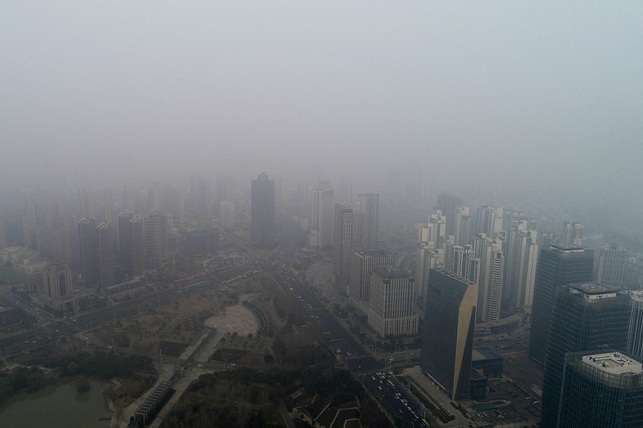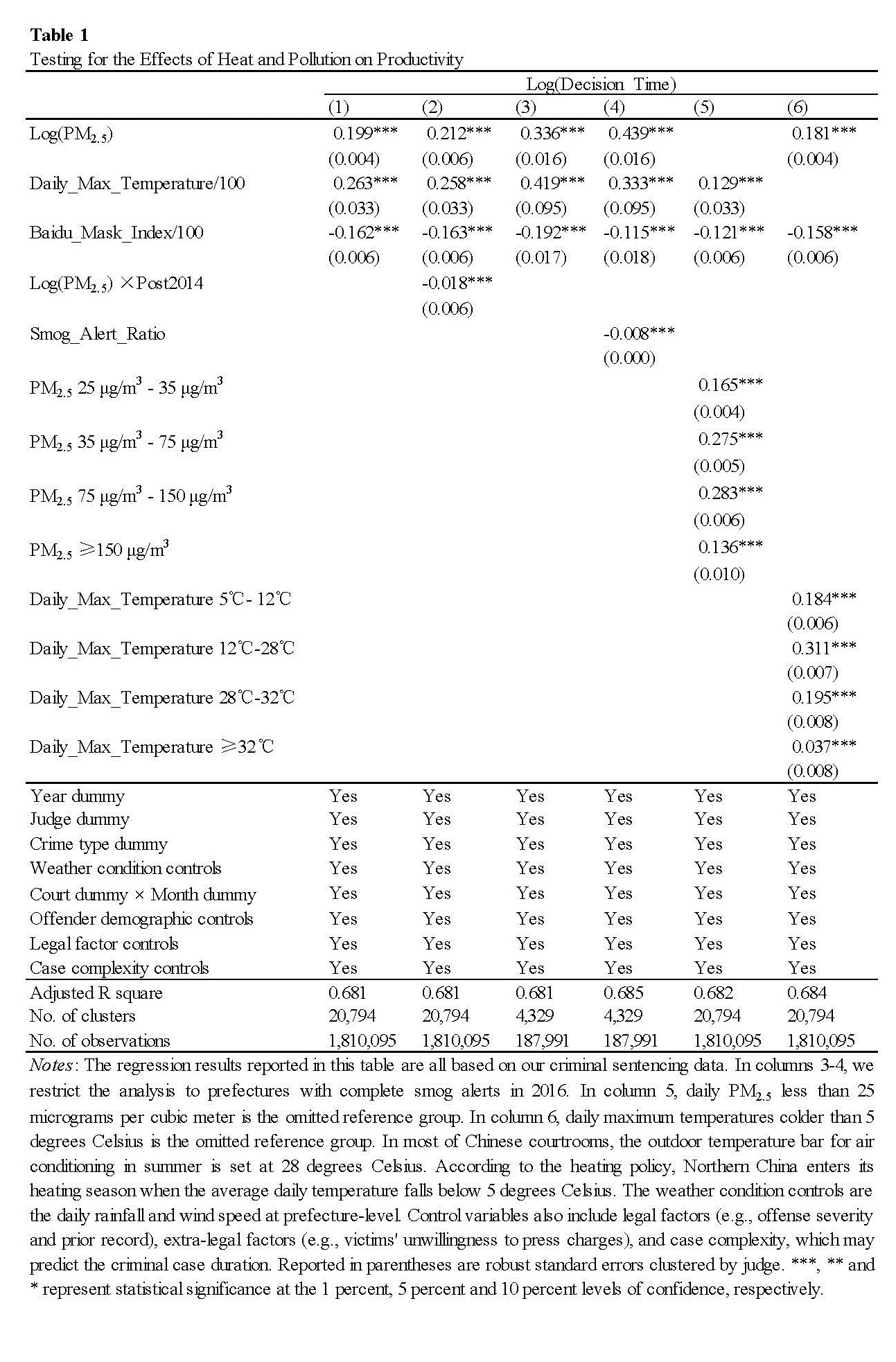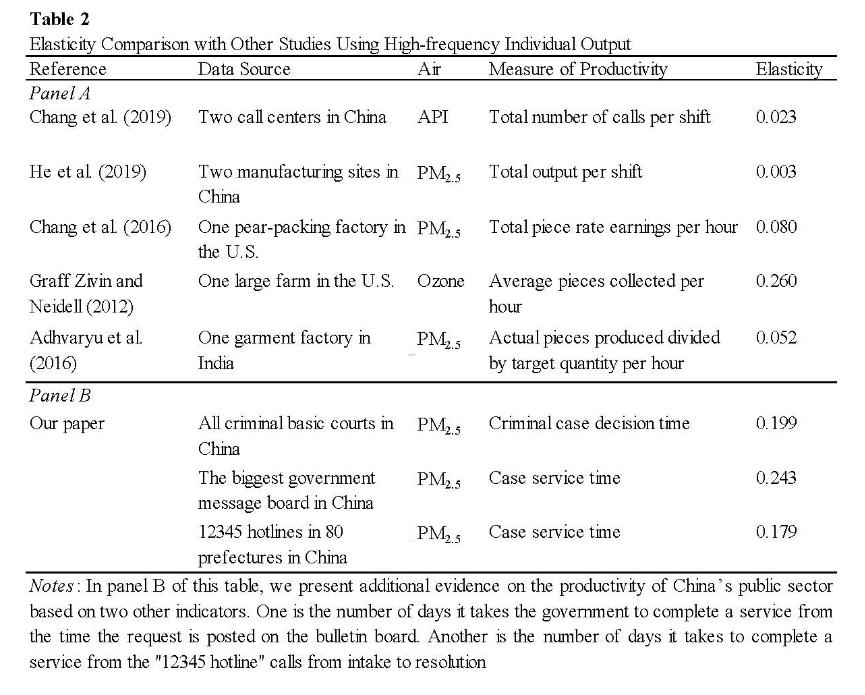The Effect of Pollution and Heat on the Productivity of High-Skill Public Sector Workers in China
The quality of governance depends on public sector worker productivity. We use micro data from China to document that judges are less productive on polluted days. We find that public sector productivity elasticities are larger than the published estimates of private sector productivity elasticities with respect to pollution.

The quality of a government plays an essential role in promoting long-run economic growth and developing increased trust in institutions. Both heat and pollution can reduce the public sector’s short-run productivity; however, some government measures can mitigate the worst of the effects. These effects are likely to be larger in the developing world relative to developed nations. Recent research has documented that both private sector agricultural workers and indoor workers perform worse when the outdoors is more polluted and hotter (Adhvaryu et al. 2014; Chang et al. 2016; Chang et al. 2019; Graff Zivin and Neidell 2012; He et al. 2019).
We examine the effects of pollution and heat on public sector worker productivity in China by examining the decision time to rule on a given case, measured by the time elapsed between the date a case is assigned to a judge and the date when the case is adjudicated by that judge. A longer deliberation period creates docket congestion and delays. Thus, decision time is a useful metric of worker productivity. Our study looks at the decisions made by 135,924 judges in 9.7 million criminal and civil cases adjudicated during the years 2014 to 2016. The judges work in 337 different prefectures and all are highly educated and well-compensated. Given China’s high levels of pollution and hot summers, this dataset offers substantial variation to test how educated elite civil servants adapt to extreme conditions.
In studying the relationship between judicial performance and pollution and heat, the features of China’s justice system allow us to avoid several identification challenges. First, within the same court, each defendant’s case is in principle randomly assigned to a judge who presides over the trial, plea bargaining, and sentencing process. The judge is also unaware of the details of upcoming cases. Second, the case duration can be several months between the filing of the claim to case resolution. Despite adjudications being made indoors, the judge in charge might conduct on-site investigations to determine the real reasons for the litigation. They might be exposed to heat and pollution both indoors and outdoors before they make their final decisions. Third, individual judges have a high degree of personal discretion and independence in the way in which they evaluate files. Finally, given the extremely heavy caseload on the judge's docket, judges only preside in one courthouse. Trial court decisions are generally final because appeals are only available on limited bases, occur infrequently, and seldom lead to a decision reversal in China.
We find that during polluted days, judges in China do not perform as efficiently. As shown in column 1 of Table 1, a 1 percent increase in PM2.5 leads to a 19.9 percent increase in the time in which a case is handled. Judges have trouble ruling on more complex cases and are more likely to make decisions that are appealed and overruled (Kahn and Li 2019). These findings contribute an emerging body of environmental economics literature exploring the productivity costs for urban workers due to environmental exposure.
Our findings document that judges are both affected by heat and pollution; however, we also find that they are adapting to these conditions. The adverse impact of PM2.5 is widely-known to the Chinese populace after 2014. We find that judges have become better at adapting to PM2.5 over time once they were made aware of the threat of heat and pollution to their decision-making (see column 2 of Table 1). As shown in column 4 of Table 1, a 1 percent increase in smog alert days leads to a 0.8 percent decrease in the case-handling time. Results reported in column 5 of Table 1 indicate the non-monotonic effect such that the highest level of pollution category has a smaller effect than the second highest level of pollution category. We posit that judges are engaging in more aversion behavior when outdoor pollution is at such high levels.
We also find an asymmetric relationship between temperature and decision time. As shown in column 6 of Table 1, the decision time at 5-12 degrees Celsius is 18.4 percent higher than at the reference temperature range. This decision time steadily climbs until the temperature hits 28 degrees Celsius and then falls at even higher temperatures. This pattern is consistent with the claim that China’s government effectively uses air conditioning during times of high outdoor temperatures and this indoor cooling is associated with an improvement in a judge’s workplace performance.

In contrasting our public sector estimates with some recent private sector estimates, we find that our implied elasticities are larger than the private sector elasticities (see Table 2). While we acknowledge that we examined just one sector of the Chinese government, we believe that our findings open up the possibility of exploring the general Alchian and Kessell (1962) hypothesis that the public sector uses “other people’s money” to provide high quality workplace work conditions.

Adhvaryu, Achyuta, Namrata Kala, and Anant Nyshadham. 2016. “Management and Shocks to Worker Productivity.” International Growth Centre (IGC) Working Paper F-35143-INC-1.
Aichian, A. Armen, and Reuben A. Kessel. 1962. “Competition, Monopoly, and the Pursuit of Pecuniary Gain.” In Aspects of Labor Economics. Pages 157-183. Princeton University Press.
Chang, Tom, Joshua Graff Zivin, Tal Gross, and Matthew Neidell. 2016. “Particulate Pollution and the Productivity of Pear Packers.” American Economic Journal: Economic Policy 8 (3): 141-69.
Chang, Tom, Joshua Graff Zivin, Tal Gross, and Matthew Neidell. 2019. “The Effect of Pollution on Worker Productivity: Evidence from Call-center Workers in China.” American Economic Journal: Applied Economics 11 (1): 151-72.
Graff Zivin, Joshua, and Matthew Neidell. 2012. “The Impact of Pollution on Worker Productivity.” American Economic Review 102 (7): 3652-73.
He, Jiaxiu, Haoming Liu, and Alberto Salvo. 2019. “Severe Air Pollution and Labor Productivity: Evidence from Industrial Towns in China.” American Economic Journal: Applied Economics 11 (1): 173-201.

The quality of a government plays an essential role in promoting long-run economic growth and developing increased trust in institutions. Both heat and pollution can reduce the public sector’s short-run productivity; however, some government measures can mitigate the worst of the effects. These effects are likely to be larger in the developing world relative to developed nations. Recent research has documented that both private sector agricultural workers and indoor workers perform worse when the outdoors is more polluted and hotter (Adhvaryu et al. 2014; Chang et al. 2016; Chang et al. 2019; Graff Zivin and Neidell 2012; He et al. 2019).
We examine the effects of pollution and heat on public sector worker productivity in China by examining the decision time to rule on a given case, measured by the time elapsed between the date a case is assigned to a judge and the date when the case is adjudicated by that judge. A longer deliberation period creates docket congestion and delays. Thus, decision time is a useful metric of worker productivity. Our study looks at the decisions made by 135,924 judges in 9.7 million criminal and civil cases adjudicated during the years 2014 to 2016. The judges work in 337 different prefectures and all are highly educated and well-compensated. Given China’s high levels of pollution and hot summers, this dataset offers substantial variation to test how educated elite civil servants adapt to extreme conditions.
In studying the relationship between judicial performance and pollution and heat, the features of China’s justice system allow us to avoid several identification challenges. First, within the same court, each defendant’s case is in principle randomly assigned to a judge who presides over the trial, plea bargaining, and sentencing process. The judge is also unaware of the details of upcoming cases. Second, the case duration can be several months between the filing of the claim to case resolution. Despite adjudications being made indoors, the judge in charge might conduct on-site investigations to determine the real reasons for the litigation. They might be exposed to heat and pollution both indoors and outdoors before they make their final decisions. Third, individual judges have a high degree of personal discretion and independence in the way in which they evaluate files. Finally, given the extremely heavy caseload on the judge's docket, judges only preside in one courthouse. Trial court decisions are generally final because appeals are only available on limited bases, occur infrequently, and seldom lead to a decision reversal in China.
We find that during polluted days, judges in China do not perform as efficiently. As shown in column 1 of Table 1, a 1 percent increase in PM2.5 leads to a 19.9 percent increase in the time in which a case is handled. Judges have trouble ruling on more complex cases and are more likely to make decisions that are appealed and overruled (Kahn and Li 2019). These findings contribute an emerging body of environmental economics literature exploring the productivity costs for urban workers due to environmental exposure.
Our findings document that judges are both affected by heat and pollution; however, we also find that they are adapting to these conditions. The adverse impact of PM2.5 is widely-known to the Chinese populace after 2014. We find that judges have become better at adapting to PM2.5 over time once they were made aware of the threat of heat and pollution to their decision-making (see column 2 of Table 1). As shown in column 4 of Table 1, a 1 percent increase in smog alert days leads to a 0.8 percent decrease in the case-handling time. Results reported in column 5 of Table 1 indicate the non-monotonic effect such that the highest level of pollution category has a smaller effect than the second highest level of pollution category. We posit that judges are engaging in more aversion behavior when outdoor pollution is at such high levels.
We also find an asymmetric relationship between temperature and decision time. As shown in column 6 of Table 1, the decision time at 5-12 degrees Celsius is 18.4 percent higher than at the reference temperature range. This decision time steadily climbs until the temperature hits 28 degrees Celsius and then falls at even higher temperatures. This pattern is consistent with the claim that China’s government effectively uses air conditioning during times of high outdoor temperatures and this indoor cooling is associated with an improvement in a judge’s workplace performance.


(Matthew E. Kahn, Department of Economics, University of Southern California; Pei Li, Department of Public Finance, Xiamen University.)
Adhvaryu, Achyuta, Namrata Kala, and Anant Nyshadham. 2016. “Management and Shocks to Worker Productivity.” International Growth Centre (IGC) Working Paper F-35143-INC-1.
Aichian, A. Armen, and Reuben A. Kessel. 1962. “Competition, Monopoly, and the Pursuit of Pecuniary Gain.” In Aspects of Labor Economics. Pages 157-183. Princeton University Press.
Chang, Tom, Joshua Graff Zivin, Tal Gross, and Matthew Neidell. 2016. “Particulate Pollution and the Productivity of Pear Packers.” American Economic Journal: Economic Policy 8 (3): 141-69.
Chang, Tom, Joshua Graff Zivin, Tal Gross, and Matthew Neidell. 2019. “The Effect of Pollution on Worker Productivity: Evidence from Call-center Workers in China.” American Economic Journal: Applied Economics 11 (1): 151-72.
Graff Zivin, Joshua, and Matthew Neidell. 2012. “The Impact of Pollution on Worker Productivity.” American Economic Review 102 (7): 3652-73.
He, Jiaxiu, Haoming Liu, and Alberto Salvo. 2019. “Severe Air Pollution and Labor Productivity: Evidence from Industrial Towns in China.” American Economic Journal: Applied Economics 11 (1): 173-201.
Kahn, Matthew, and Pei Li. 2019. “The Effect of Pollution and Heat on High Skill Public Sector Worker Productivity in China.” NBER Working Paper No. 25594.

Latest
Most Popular
- VoxChina Covid-19 Forum (Second Edition): China’s Post-Lockdown Economic Recovery VoxChina, Apr 18, 2020
- China’s Great Housing Boom Kaiji Chen, Yi Wen, Oct 11, 2017
- China’s Joint Venture Policy and the International Transfer of Technology Kun Jiang, Wolfgang Keller, Larry D. Qiu, William Ridley, Feb 06, 2019
- The Dark Side of the Chinese Fiscal Stimulus: Evidence from Local Government Debt Yi Huang, Marco Pagano, Ugo Panizza, Jun 28, 2017
- Wealth Redistribution in the Chinese Stock Market: the Role of Bubbles and Crashes Li An, Jiangze Bian, Dong Lou, Donghui Shi, Jul 01, 2020
- What Is Special about China’s Housing Boom? Edward L. Glaeser, Wei Huang, Yueran Ma, Andrei Shleifer, Jun 20, 2017
- Privatization and Productivity in China Yuyu Chen, Mitsuru Igami, Masayuki Sawada, Mo Xiao, Jan 31, 2018
- Evaluating Risk across Chinese Housing Markets Yongheng Deng, Joseph Gyourko, Jing Wu, Aug 02, 2017
- How did China Move Up the Global Value Chains? Hiau Looi Kee, Heiwai Tang, Aug 30, 2017
- China’s Shadow Banking Sector: Wealth Management Products and Issuing Banks Viral V. Acharya, Jun Qian, Zhishu Yang, Aug 09, 2017




 Facebook
Facebook  Twitter
Twitter  Instagram
Instagram WeChat
WeChat  Email
Email 



